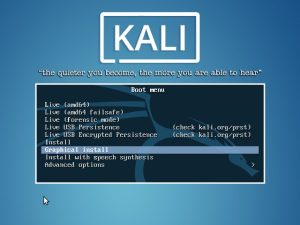Essential Facts about Kali Linux
Essential facts of Kali Linux is It has become the de-facto platform for security professionals due to a number of reasons. Kali Linux includes most of the tools required in modern penetration testing, such as tools for reconnaissance and delivering payloads. In addition You’ll learn the basics of Kali Linux and the reasons behind its ever-growing popularity from this guide.

Lets get familiar with Some essential facts about Kali Linux
- Source
- Target Audience
- Installation
-
Release Cycle
-
Desktop Environment
-
Package Management
-
Drivers and Firmware
-
Windows Compatibility
-
Virtualization Support
-
Embedded & Android Support
-
Privacy & Animosity
-
Customization
-
Documentation
-
Community Support
-
Special Features
Source of Kali Linux
At First we will talk about The developers of Kali Linux that they created it as a replacement for the earlier Back Track distribution. Back Track was a powerful platform that provided the tools required for successful penetration testing and was based on Knoppix Linux.
So Kali is a revamp of Back Track built around Debian and provides a robust set of additional features. Kali is developed for providing a full-fledged Linux desktop experience, whereas Back Track was meant to be a Live OS.
However, you can also use Kali as a live OS like other Standard Linux distribution and boot it on the fly using a CD, DVD, or USB flash drive. It has been a huge success for the developers and was downloaded more than 100,000 times during its first week of release. The developers are actively working on this OS and roll out new features pretty often.
Target Audience of Kali Linux
Kali offers a fully functional desktop build that anyone can use. However, this is especially for professionals that they working actively in the information security industry. Although it can be easily used by home users, our editors do not recommend it because most of the tools they need should lead to increased scores. It’s generally considered a bad idea to operate your machine as the root user unless you clearly know exactly what you are doing.
A common misconception regarding Kali is that it’s a hacking distribution. This is entirely wrong since Kali is just an OS with common security tools. Most of these tools can be used in any traditional Linux distro and would provide the same operations.
Installation of Kali Linux
You can install the Kali OS in any traditional x86, x86-64, and ARM platforms. It is an open-source distribution that offers ready-made ISO images alongside images for VMware and ARM-based devices. However, you should always download the required images from official sources and confirm the SHA256 check boxes to ensure that the image is not incorrect with. Beginners often make the mistake of downloading the ISO from third-party sources and make their system vulnerable.

Kali has a medium memory footprint and requires around 3 gigabytes of free disk space for the installation process. You can run it on legacy machines that have as low as 512MB of RAM. However, you should install it on an SSD drive and have at least 2GB RAM if you’re looking for a smooth desktop experience.
Release Cycle
Kali addresses some major problems related to specialized security systems via implementing a rolling release model. This is similar to systems like Arch and Gentoo, where the system packages receive frequent updates with small differences.
This helps Kali to make sure that users always have the latest security tools alongside patching newfound bugs. Although many people tend to dislike this release model due to the seemingly unending amount of updates, it helps security professionals keep their platforms up to date.
Desktop Environment of Kali Linux
GNOME was the default desktop environment for Kali Linux till last year when it was switched to XFCE. Although you can still download a GNOME-based image, new users are encouraged to download the default image.
This new, XFCE-based environment makes a significant improvement over the last one in terms of performance and user experience. The GNOME version often hampered the experience in even modest machines. Fortunately, this issue has been successfully resolved with the new selection.
Moreover, Kali also offers KDE environments for experienced Linux users with access to beefier machines. If you’re a fan of cool applications and unlimited customization capabilities, it’s worth a try. You also get to choose from Cinnamon, MATE, and the LXDE environment. So Kali certainly covers this ground pretty well.
Package Management
It uses the Debian-based package manager dpkg. So you can easily install new applications that offer a .deb executable. Installing packages that do not provide a .deb file can be tricky for new users. However, they’ll still be able to compile the packages from source using standard Linux development tools like make and install.
So You can install RPM files for using tools like “alien” that convert the RPM package into a DEB one. The apt command allows users to search and install their favorite Linux packages directly from the terminal. Graphical software like the Synaptic Package Manager is also available as in other distributions.
Drivers and Firmware
One noted drawback of Kali Linux is that it falls significantly short on supporting drivers and firmware. Although developers are always trying to support newer drivers, it has proven to be hard work. One notable problem users face recurring issues with wireless drivers. Sometimes you may even need to install specific firmware to get around issues with incompatible drivers.
and You may also face problems with GPU drivers. Although Kali developers try to support commercial Nvidia cards, you will often encounter compatibility issues. However, since Kali’s target users are penetration testers and security experts, they often don’t require GPU supports at all. But if you’re a gamer, it can be seriously frustrating sometimes.
Windows Compatibility of Kali Linux
Although it’s hard to find real penetration testers using Windows as their primary system,and many people would be happy to access Kali tools and features from their Windows workstation. Fortunately, the newly developed WSL (Windows subsystem for Linux) enables users to do exactly this. This is a compatibility layer for Windows, allowing users to run Linux executable directly from their Windows 10 system.
Virtualization Support
Virtualization is the method of using virtual platforms for running high-demanding computer services. Kali’s virtualization support includes the ability to reside inside Linux virtual machines, pre-built ISO images for VMware, Virtual Box, Hyper-V, and Vagrant alongside support for containerization platforms Docker and LXC. So, you can install Kali Linux in any standard platform that relies on virtualization without facing additional hassles.
VMware is absolutely the best choice for professionals working with high-performance systems. Kali offers excellent support for Open-vm-tools (OVT) alongside other essential applications. Moreover, the availability of official images for Docker and LXC saves significant time for security occupations.
Embedded & Android Support
As We explained earlier, Kali supports a wide variety of ARM-based embedded devices such as Raspberry Pie, Beaglebone, Odroid, HP & Samsung Chromebook, among many more. Admins can choose from a number of lightweight images to set up simple but Kali platforms.
Privacy & Animosity of Kali Linux
Kali is very quiet by design. This is one of the primary reasons why security experts use this instead of traditional Linux distributions. Standard distributions usually send network packets over the network at a regular interval and may have several unmonitored services running on different ports. Thus, they are prone to network scans and lose the animosity craved by security professionals and malicious users.
Experts and professionals can also rely on Kali’s advanced encryption methods to keep their machines and data secure. You can even encrypt your bootable Kali OS if you want. So overall, It is an excellent choice for both security researchers and privacy-concerned users.
Customization
Although most Linux distributions are extremely customizable, But Kali takes this to a whole new level. It allows us to build personalized systems by changing the source and creating custom ISOs. You can choose only to keep the packages required by your job out of the 600 plus available security tools that Kali has to offer. We’ve already gone over the desktop environments, which allow users to create personalized user experiences very easily.
Documentation of Kali Linux
Acceptable documentation is important for specialized Linux distributions like Kali. Fortunately, the developers know this and provide some excellent resources that include detailed information about the essential topics. We really enthusiastic to know how these resources are created and can confidently say that it’ll help you learn Kali much faster.
Additionally, there are a plethora of video tutorials as well as Kali cookbooks from reputed publications that teach many complex features of Kali. If you’re a seasoned security professional looking to master advanced Kali functionalities, you can easily do so by consulting some of these resources.
Community Support
Kali has a thriving community filled with security experts who are always willing to help people with their problems. The development of these communities dates back to BackTrack and offers excellent advice on starting penetration testers. The Offensive Security team maintains the official Kali website, blog, forums, IRC channels, Git repository, and bug tracker for Kali alongside social media feeds like Twitter and Facebook.
Special Features of Kali Linux
Kali advices a great list of additional features absent in traditional Linux distributions. The ISO of Doom is an excellent example of a special Kali feature. It’s an advanced recipe for building custom images that can install themselves automatically, reverse VPM auto-connections, and create network bridges, among others.

The multi-level live USB persistence allows users to made bootable Kali drives with support for multiple encrypted profiles. The Kali meta-package collection offers tools for quickly building minimized system environments. Users can also set up cloud versions of Kali in the Amazon Elastic Compute Cloud using the Amazon EC2 AWS images. Some other notable features include accessibility for blind or visually impaired users and the bootable forensic mode.
Conclusion
Kali Linux is known for its vast collection of security tools as well as a privacy-focused feature set. If you want to learn penetration testing from scratch, it can be the ideal companion for you. Moreover, seasoned, ethical hackers can leverage Kali to perform faster security audits.
As result We hope this article would be useful for you.











